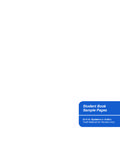Transcription of Alternative Ways of Providing Water Alternative Ways of ...
1 Alternative ways of Providing Water Emerging Options and Their Policy Implications It is not clear how prevailing Water systems in OECD countries will adjust to urban Water challenges. These systems are based on piped Water supply in centralized systems using a series of accepted technologies. They consume a lot of fresh Water and energy. Alternative Water systems exist, which use Alternative sources of Water : rain Water , (treated or not treated) grey or reclaimed Water . They can be organised at different scales, including at decentralised levels. Such systems are deployed in rural areas and in emerging cities. They are in use in countries like Australia, Spain, some states in the US, which are aware of the price of Water scarcity. However, their deployment in urban areas is implicitly restrained in most OECD. countries. The report examines the pros and cons of such systems, and the contexts in which they may be appropriate.
2 It argues that OECD countries would benefit from exploring the potential of such Alternative Water systems, to address the challenges of urban Water supply. It identifies Alternative ways of Providing Water Emerging Options and Their Policy Implications . ENVIRONMENT. the policy reforms that have to be implemented before the full benefits of these systems can be realised and the risks they generate can be mitigated. The focus is on urban areas in OECD. countries. This report is part of the Horizontal Programme on Water carried out by the OECD in 2007- 08. The main findings and recommendations resulting from this programme are summarized in Managing Water for All: an OECD Perspective on Pricing and Financing. The key messages are presented in Managing Water for All: an OECD Perspective on Pricing and Financing Key Messages for Policy Makers. For more information, please visit: Advance copy for 5th World Water Forum FOREWORD.
3 Reused Water (either reclaimed Water or grey Water reuse) is increasingly considered a sustainable source for some uses of Water . It is regarded as one option to address the increasing mismatch between available Water resources and rising demand, in both OECD and developing countries. Reused Water can be supplied from either centralized or decentralized systems. This report reviews the pros and cons of Alternative sources of Water (reused Water and rainwater). and of decentralized systems to collect, produce and use them. It assesses lessons learned and the main policy issues which have to be addressed before such Alternative ways of Providing Water can be widely applied; the focus is on urban areas in OECD countries. The report builds on the analyses developed in the context of the OECD project on Infrastructure to 2030 (OECD, 2007a, b), on a literature review and on a series of discussions with experts.
4 This report is part of the wider OECD Horizontal Water Programme on Sustainable Financing to Ensure Affordable Access to Water Supply and Sanitation . The Programme addresses the economic basis for sustainable Water and sanitation services and for sound Water resources management. In particular, it addresses two related sets of policy questions of high priority on the international agenda: i) how to overcome the financial obstacles to the provision of adequate, affordable and sustainable Water and sanitation services for all, while ensuring revenue sufficiency for service providers, and ii). how to improve the use of economic incentives to encourage management of Water resources that is both economically efficient and environmentally sustainable. The main conclusions of the OECD. Horizontal Water Programme are synthesized in a synthesis report (OECD, 2009) and in a series of analytical reports (available at ).
5 The report was written by Xavier Leflaive, Principal Administrator, OECD, Environment Directorate, Environment and Globalisation Division. It has benefited from discussions during the SIWI GWP EUWI Workshop on Progress in Financing Water Services at the Stockholm Water Week (August 2007) and the OECD Expert Meeting Sustainable Financing for Affordable Water Services: From Theory to Practice" (November 2007). The contributions of following experts who have taken time to answer questions and share ideas in the course of this and related projects are gratefully acknowledged: Jeff Ball (Orenco Systems), J. Freedman and James W. Hotchkies (General Electric), Peter Gleick and Meena Palaniappan (Pacific Institute), Hans G. Huber (Huber Technologies), Michel Le Sommer (Le Sommer Environnement), David Lloyd Owen (Envisager), Dominique Lorrain (EHESS), Jack Moss (Aquafed), Peter Shanaghan (USEPA), James Winpenny (Wychwood Consult).
6 The report benefited from comments from the team of the OECD Horizontal Water Programme, under the supervision of Brendan Gillespie, in particular Peter B rkey, C line Kaufman, Roberto Martin-Hurtado, Monica Scatasta. All errors and inconsistencies remain the author s responsibility. 1. TABLE OF CONTENTS. FOREWORD .. 1. EXECUTIVE SUMMARY .. 3. INTRODUCTION .. 6. OPPORTUNITIES FOR Alternative Water SYSTEMS .. 7. Challenges that prevailing approaches face in OECD countries .. 7. Trends in the provision of Water supply .. 10. pros AND cons OF Alternative Water SYSTEMS .. 16. Cost factors for Water reuse and decentralized 16. Harnessing new sources of finance: capturing some of the rent attached to Water services .. 19. Contextual features .. 22. POLICY CONCLUSIONS .. 23. Address public concerns .. 25. Adjust governance .. 26. Reform institutions .. 27. Adjust the regulatory framework .. 27. Create markets for Alternative Water systems.
7 30. 31. Tables Table 1. A typology of ways of Providing Water and sanitation .. 11. Table 2. pros and cons of Alternative ways of Providing Water and 23. Boxes Box 1. Water Reuse at the Olympics: Beijing Bei Xiao He .. 13. Box 2. Water reclamation, Hong Kong .. 14. Box 3. Land value capture and new infrastructure: the Copenhagen metro, Denmark .. 20. Box 4. Inset appointments in England .. 21. Box 5. Innovation in a Greenfield Site: the Gap, Brisbane .. 25. Box 6. Structuring policy dialogue on Water reuse. The case of San Diego California .. 26. Box 7. French decree authorizing rainwater harvesting for indoor non-potable uses .. 29. 2. EXECUTIVE SUMMARY. Populations in most OECD countries enjoy high levels of access to networked systems of Water supply and sanitation. However, the maintenance of these systems is becoming more difficult because of the major investments required to repair and replace ageing infrastructure and the costs associated with meeting more stringent environmental requirements.
8 It is expected that half of OECD countries will have to increase the level of expenditure on Water infrastructure as percentage of GDP (OECD, 2007a). In addition, questions arise about the articulation of such services with Water management issues. Water scarcity, the benefits of adjusting Water quality to needs, the concern for making a better use of available resources, all argue that Water supply services should be adaptable, resilient and flexible. In this context, the traditional economies of scale attached to piped Water supply, single Water use, and Water -borne sewage treatment in centralized systems are being questioned. There are diseconomies of scale attached to large municipal systems for supplying Water , in particular in megacities where high costs are attached to Water transport and network maintenance, including work on roads to repair underground infrastructure. The strong technical path dependency of existing infrastructures generates rigidities which may be problematic in the context characterized above.
9 Some governments and the private sector are examining Alternative ways of Providing Water . In particular, reuse of (treated or not treated) grey or reclaimed Water attracts a lot of attention, as it provides an Alternative source of Water . Reuse can be organised at different scales and, as noted by Yang and Abbaspour (2007), one key question from a policy perspective is to determine the optimal scale of wastewater reuse, from a technical, socio-economic, environmental and institutional perspective. Alternative Water systems differ from prevailing ones in at least one of two dimensions: i) they reclaim and reuse Water for a variety of uses; ii) they can be based on decentralized infrastructures, producing Water where it is consumed. Markets for Water reuse are booming. Experience with decentralized Water accumulates in emerging economies and in rural areas; experience is more limited in OECD urban areas.
10 Australia, Spain, some states in the US are pioneering these new technologies, spurred by serious constraints on Water resources. There are debates about the pros and cons of Alternative Water systems, and about the contexts where they might be viable. This paper sheds some light on these debates, by reviewing the literature and available case studies. It identifies contexts where Alternative Water systems might be considered as an option for OECD governments and municipalities. It identifies a number of policy issues which have to be addressed before these systems can be deployed and contribute to tackling the challenges OECD countries face regarding Water supply. This is a preliminary exploration and more work is needed to collect evidence and bring more light on these and related issues. 3. pros and cons of Alternative Water systems Alternative systems have pros and cons . The discussion focuses on selected issues, namely: the investment and operating costs.















